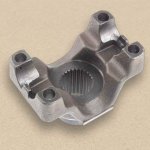I’m looking for some ideas on how to check a part. It looks VERY similar to the part in this link.
Yukon Gear & Axle YY D44-1310-26U Pinion Yoke | Walmart Canada
I need to check the relation of the two half-bores. Their centerlines need to be colinear within a specified tolerance.
How would you check that? I do not have a CMM. I can check in the machine, but that has its pitfalls.
The machining done to the part is the first operation on a forging, so there are no other machined surfaces to reference other than the four faces with the bolt holes in them that I am machining in the same operation.
Nothing we have tried has given readings that I am confident in. Hopefully, someone out there has come across this situation before. Thanks!
Yukon Gear & Axle YY D44-1310-26U Pinion Yoke | Walmart Canada
I need to check the relation of the two half-bores. Their centerlines need to be colinear within a specified tolerance.
How would you check that? I do not have a CMM. I can check in the machine, but that has its pitfalls.
The machining done to the part is the first operation on a forging, so there are no other machined surfaces to reference other than the four faces with the bolt holes in them that I am machining in the same operation.
Nothing we have tried has given readings that I am confident in. Hopefully, someone out there has come across this situation before. Thanks!



